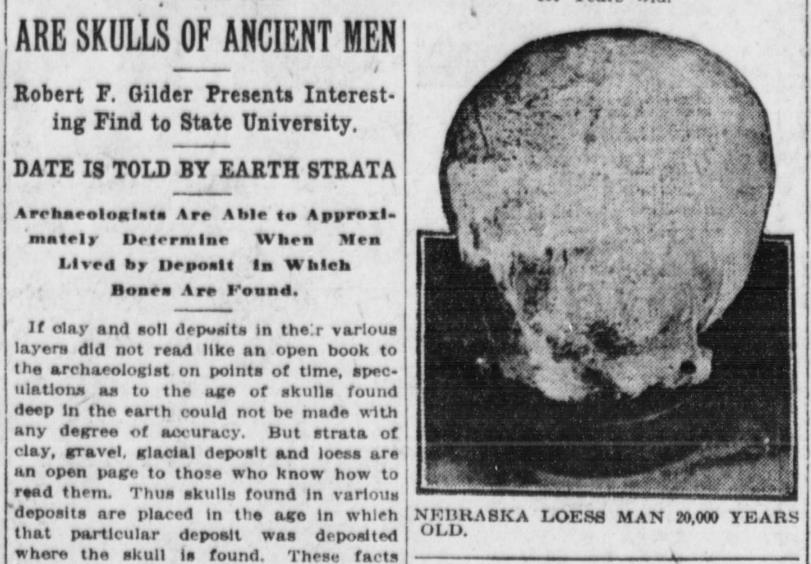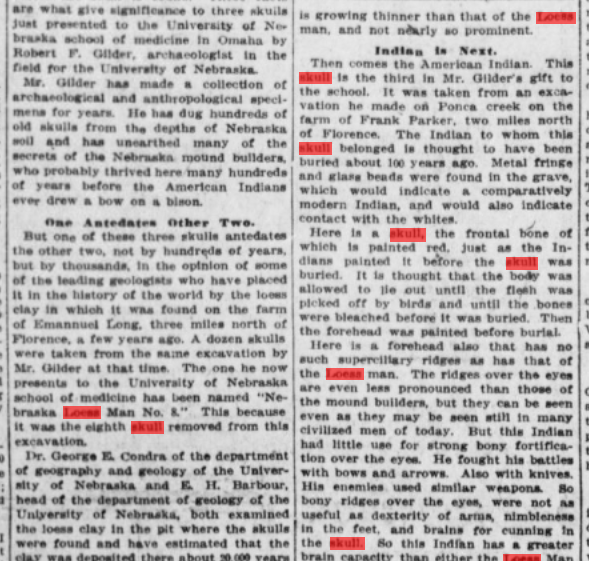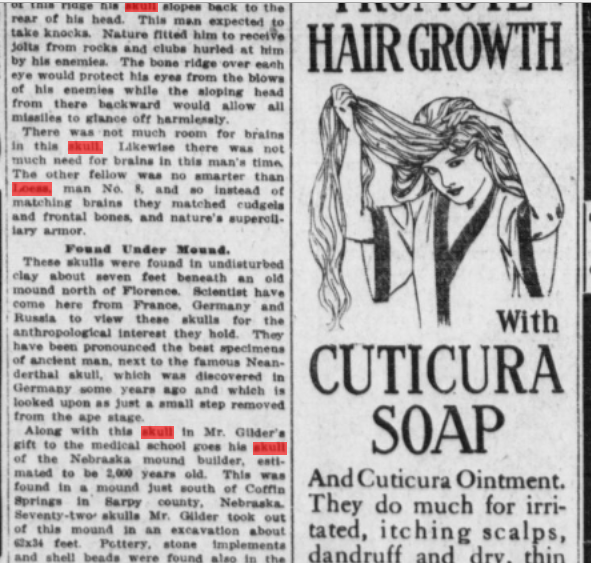Nebraska Loess Man
Nebraska Loess Man
Nebraska Mound Builder Site Yields 2,000-Year-Old Skulls of Ancient Men
Robert F. Gilder presents an interesting find to the State University. The date is told by earth strata. Archaeologists are able to approximately date the era when men lived based on deposits in which bones are found.
If clay and soil deposits in their various layers did not read like an open book to the archaeologist on points of time, speculations as to the age of skulls found deep in the earth could not be made with any degree of accuracy. But strata of clay, gravel, glacial deposits, and loess are an open page to those who know how to read them. Thus, skulls found in various deposits are placed in the age in which that particular deposit was deposited where the skull is found. These facts are what give significance to three skulls just presented to the University of Nebraska School of Medicine in Omaha by Robert F. Gilder, an archaeologist in the field for the University of Nebraska.
Mr. Gilder has made a collection of archaeological and anthropological specimens for years. He has dug hundreds of old skulls from the depths of Nebraska soil and has unearthed many of the secrets of the Nebraska mound builders, who probably thrived here many hundreds of years before the American Indians ever drew a bow on a bison.
One Antedates Other Two. But one of these three skulls antedates the other two, not by hundreds of years, but by thousands, in the opinion of some of the leading geologists who have placed it in the history of the world by the loess clay in which it was found on the farm of Emmanuel Cong, three miles north of Florence, a few years ago. A dozen skulls were taken from the same excavation by Mr. Gilder at that time. The one he now presents to the University of Nebraska School of Medicine has been named “Nebraska Loess Man No. 8.” This is because it was the eighth skull removed from this excavation.
Dr. George E. Condra of the Department of Geography and Geology of the University of Nebraska and E.H. Barbour, head of the Department of Geology of the University of Nebraska, both examined the loess clay in the pit where the skulls were found and have estimated that the clay was deposited there about 20,000 years ago. This is taken to mean that the man upon whose shoulders this fierce skull once rested lived 20,000 years ago.
Now to evolutionists, this is very interesting, for a glance at the skull will suggest the skull of an ape or orangutan rather than that of a man. And why not? say the archaeologists, for that was a long time ago, and we all know that civilization had not made very big leaps at that time. We had no trust bosses then to sit in swivel chairs and manipulate finances, making millions with the nod of their head. It was not a matter of making millions then. It was a matter of capturing a hindquarter of some wild beast of the forest for food. When game was scarce, it was a matter of batting the brains out of your neighbor with a stone cudgel to get him out of the way so that you might have the hunk of meat he had killed.
As the old frontiersman says, “It took a man to live in them days;” so did it require a combination of fighting flesh and bone to walk the earth then and survive. Skull was thick.
So Nebraska Loess Man No. 8, being one who was fit to survive in those hardy times, had a superciliary ridge over each eye that would ward off a lick from a ball bat swung by some of the league players of the present day. He had almost no forehead at all. The superciliary ridge over each eye is as pronounced as a flange on a car wheel, while back of this ridge his skull slopes back to the rear of his head. This man expected to take knocks. Nature fitted him to receive jolts from rocks and clubs hurled at him by his enemies. The bone ridge over each eye would protect his eyes from the blows of his enemies while the sloping head from there backward would allow all missiles to glance off harmlessly.
There was not much room for brains in this skull. Likewise, there was not much need for brains in this man’s time. The other fellow was no smarter than Loess man No. 8, and so instead of matching brains, they matched cudgels and frontal bones and nature’s superciliary armor.
Found Under Mound
These skulls were found in undisturbed clay about seven feet beneath an old mound north of Florence. Scientists have come here from France, Germany, and Russia to view these skulls for the anthropological interest they hold. They have been pronounced the best specimens of ancient man, next to the famous Neanderthal skull, which was discovered in Germany some years ago and which is looked upon as just a small step removed from the ape stage.
Along with this skull in Mr. Gilder’s gift to the medical school goes his skull of the Nebraska mound builder, estimated to be 8,000 years old. This was found in a mound just south of Coffin Springs in Sarpy County, Nebraska.
Seventy-two skulls Mr. Gilder took out of this mound in one excavation about 50 feet. Pottery, stone implements, and shell beads were found also in the excavation.
This skull has a much more pronounced forehead than the Loess skull. In fact, there is almost no comparison, although the mound builder has no forehead to compare favorably with the average intelligent American citizen of today. Also, the superciliary or supraorbital ridge over the eye is no longer so pronounced. The ridge can, of course, be seen, but it is an American Indian, 100 Years Old.
NEBRASKA LOESS MAN 20,000 YEARS OLD.
Is growing thinner than that of the Loess man, and not nearly so prominent.
Indian Skull.
Then comes the American Indian. This skull is the third in Mr. Glider’s gift to the school. It was taken from an excavation he made on Ponca creek on the farm of Frank Parker, two miles north of Florence. The Indian to whom this skull belonged is thought to have been buried about 100 years ago. Metal fringe and glass beads were found in the grave, which would indicate a comparatively modern Indian, and would also indicate contact with the whites.
Here is a skull, the frontal bone of which is painted red. But as the Indians painted it before the skull was buried. It is thought that the body was allowed to lie out until the flesh was picked off by birds and until the bones were bleached before it was buried. Then the forehead was painted before burial.
Here is a forehead also that has no such superciliary ridges as has that of the Loess man. The ridges over the eyes are even less pronounced than those of the mound builders, but they can be seen even as they may be seen still in many civilized men of today. But this Indian had little use for strong bony fortification over the eyes. He fought his battles with bows and arrows. Also with knives. His enemies used similar weapons. So bony ridges over the eyes were not as useful as dexterity of arms, nimbleness in the feet, and brains for cunning in the skull. So this Indian has a greater brain capacity than either the Loess Man or the mound builder. His forehead is better developed, and his head is wider.
Omaha daily bee., November 16, 1913, PART ONE, Page 14-A, Image 14
- Omaha daily bee., November 16, 1913, PART ONE, Page 14-A, Image 14.
- November 16, 1913, PART ONE, Page 14-A, Image 14
~Chris L Lesley/GAWMuseum






Comment